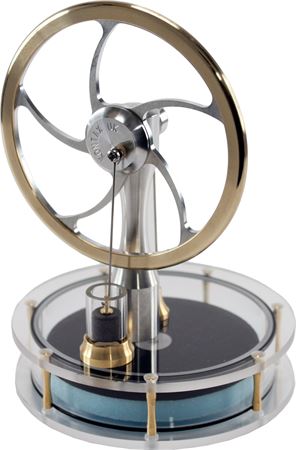What is a Stirling Engine?
Stirling engines convert a small temperature difference into motion. As long as one plate is warmer (about 5°c) than the other then the engine will run. It doesn't matter which plate is warmer, as long as the other is cooler. If you reverse the temperature differential, and cool the plate that was warm, and warm the plate that was cool then the engine will run in reverse. The Stirling engine is named after its inventor, Rev. Robert Stirling, who patented his idea in 1816.
|
How do they work?
Stirling engines work by cyclically heating and cooling the air inside the main chamber. As the air heats up it expands, and as it cools down it contracts. This expansion and contraction drives a small piston which in turn drives the flywheel. The clever thing about Stirling engines is that the mechanism for cycling the heating and cooling of the air is built into the engine in the form of the displacer, which is driven by the flywheel and moves the air from the warm side to the cool side and back again over and over.
|
Eco-friendly
The Kontax KS90 Low Temperature Differential Stirling Engine is the ultimate eco-friendly device, showing with one spin of the flywheel a clean and simple way of converting waste heat into motion. Because these engines rely on a temperature difference for operation, they will run on almost any source of warmth. Typical heat sources include hot coffee or tea, warm sunlight, CRT monitor, TV digibox and the human hand.
|
Efficiency
Because Stirling engines have a theoretical 40% greater efficiency than photo-voltaic (PV) panels worldwide energy companies are investigating using them as a way to provide energy in a more sustainable and environmentally friendly way. Such companies use our full range of low temperature engines to demonstrate the principles behind generating electricity using Stirling engines.
|





